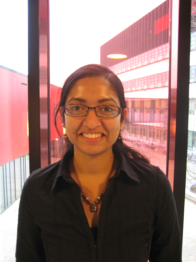Near-field investigation of surface plasmon polaritons
Promotion date: 9. December 2010
Promotors: Prof. dr. Jennifer Herek
Assistant Promotor: Dr. ir. Herman Offerhaus
| The interaction of light with a thin film of a noble metal (for example, gold) contains a resonant phenomenon due to the collective oscillation of free electrons on the surface of the metal. The collective oscillation, known as surface plasmon polaritons, is highly sensitive to a change in the refractive index of the medium bounding the metal. The thesis presents results of a near-field investigation of surface plasmon polaritons on gold thin films and gratings, using a home-built near-field scanning optical microscope. The ideas described in the thesis - to measure the phase shift and to reduce scattering of the surface plasmon polaritons - are intended to improve the sensitivity and dynamic range of surface plasmon resonance bio-sensors. |
Do you remember a special moment during your thesis project?
In the last year of my PhD, we managed to successfully fabricate a new kind of structure, called a buried grating, in collaboration with the Molecular Nanofabrication Group, run by professor Jurriaan Huskens. It took about three years to find an appropriate method to fabricate the buried grating. We found that the scattering of surface plasmons was decreased significantly, resulting in “sharp” resonance peaks. We were able to measure the sharp resonance using a home-built near-field scanning optical microscope.
Building this microscope, you did carry this out parallel to the investigations?
Yes, it was part of the job. The original microscope, which was a similar one, moved along with our former group leader to ICFO, Barcelona. We had the expertise and knowledge in our group to build one from scratch.
In fact, I could mention this as a second important moment during my thesis work. Within the first year of my PhD, we were able to observe the phase variations of light in the phenomenon of total internal reflection in a glass-air and a glass-gold-air system, using the new microscope. Our approach was the first near-field demonstration of the phenomenon, which led to a publication in Optics Express, at a very early stage. Right now, we have two manuscripts in the peer review process as well as one in preparation.
In what way did you develop as a scientist and researcher in these four years?
I am better capable of interpreting my results in comparison to my master project, in which I studied semiconductor thin films. As a scientist, you have to be able to convince both yourself and others, communicate your results and collaborate with experts from varying disciplines, in order to take your investigations further.
Also, I liked working in the cleanroom, learning different fabrication skills and interacting with the technical experts. The quality of my samples was stunning by working in the ultraclean environment. The experimental results I obtained are truly fulfilling. It was worth all the time and efforts.
What are your future plans?
I am now going to work as a post-doc at the University of Minnesota, to guide them building a similar microscope to investigate biological samples. The research also involves exploring plasmonic nanostructures for sensing and solar cell applications.
I am striving for an academic career, rather than working in a company setting. I feel that academia is more free and flexible, and also I love to work with students, leading them towards a professional level.
Hopefully, in the future, I am able to become a leader of a research group. That goal is defining my direction right now. First of all I have to widen my scientific perspective, and also get more in-depth knowledge to develop successful research strategies.
What is, in your opinion, important for Mesa+ to maintain, or even improve, the international level of research?
I liked the annual meetings, for example. Here I could meet my friends and talk to them about scientific subjects. Also, it is interesting to find out what your colleagues are doing.
Perhaps, interaction between PhD’s could be more frequent and more structured, for example by organizing small lab tours. Young researchers are flexible and eager to learn. While working in the laboratories and cleanroom they encounter a lot of similar problems, which they could solve by open communication and helping out one another. By talking to peers in other research groups, they also could steer and shape their own projects to dimensions which they otherwise might not have known. I am sure this will be fruitful, as they all share common ambition and research attitude.

